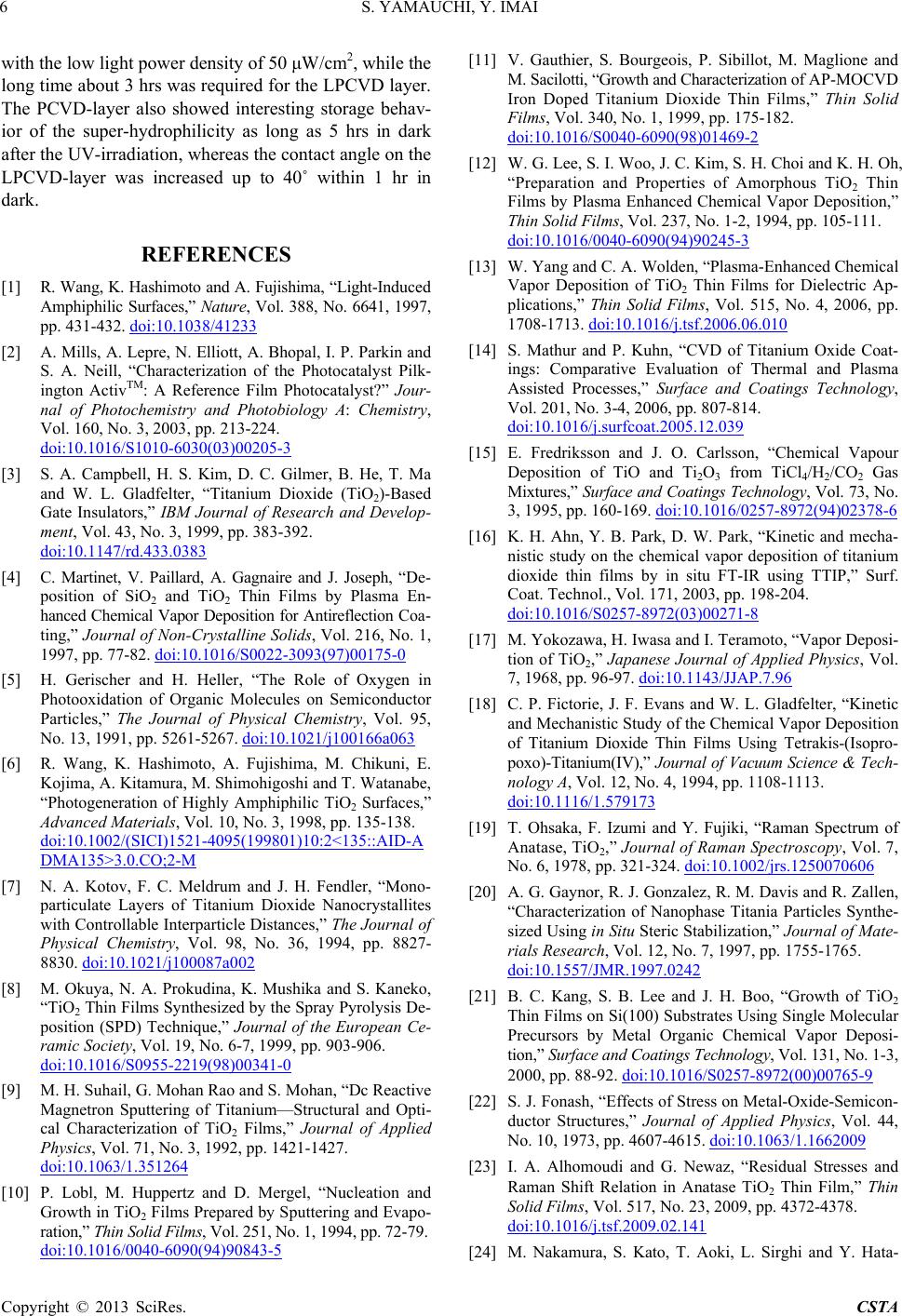
S. YAMAUCHI, Y. IMAI
6
with the low light power density of 50 μW/cm2, while the
long time about 3 hrs was required for the LPCVD layer.
The PCVD-layer also showed interesting storage behav-
ior of the super-hydrophilicity as long as 5 hrs in dark
after the UV-irradiation, whereas the contact angle on the
LPCVD-layer was increased up to 40˚ within 1 hr in
dark.
REFERENCES
[1] R. Wang, K. Hashimoto and A. Fujishima, “Light-Induced
Amphiphilic Surfaces,” Nature, Vol. 388, No. 6641, 1997,
pp. 431-432. doi:10.1038/41233
[2] A. Mills, A. Lepre, N. Elliott, A. Bhopal, I. P. Parkin and
S. A. Neill, “Characterization of the Photocatalyst Pilk-
ington ActivTM: A Reference Film Photocatalyst?” Jour-
nal of Photochemistry and Photobiology A: Chemistry,
Vol. 160, No. 3, 2003, pp. 213-224.
doi:10.1016/S1010-6030(03)00205-3
[3] S. A. Campbell, H. S. Kim, D. C. Gilmer, B. He, T. Ma
and W. L. Gladfelter, “Titanium Dioxide (TiO2)-Based
Gate Insulators,” IBM Journal of Research and Develop-
ment, Vol. 43, No. 3, 1999, pp. 383-392.
doi:10.1147/rd.433.0383
[4] C. Martinet, V. Paillard, A. Gagnaire and J. Joseph, “De-
position of SiO2 and TiO2 Thin Films by Plasma En-
hanced Chemical Vapor Deposition for Antireflection Coa-
ting,” Journal of Non-Crystalline Solids, Vol. 216, No. 1,
1997, pp. 77-82. doi:10.1016/S0022-3093(97)00175-0
[5] H. Gerischer and H. Heller, “The Role of Oxygen in
Photooxidation of Organic Molecules on Semiconductor
Particles,” The Journal of Physical Chemistry, Vol. 95,
No. 13, 1991, pp. 5261-5267. doi:10.1021/j100166a063
[6] R. Wang, K. Hashimoto, A. Fujishima, M. Chikuni, E.
Kojima, A. Kitamura, M. Shimohigoshi and T. Watanabe,
“Photogeneration of Highly Amphiphilic TiO2 Surfaces,”
Advanced Materials, Vol. 10, No. 3, 1998, pp. 135-138.
doi:10.1002/(SICI)1521-4095(199801)10:2<135::AID-A
DMA135>3.0.CO;2-M
[7] N. A. Kotov, F. C. Meldrum and J. H. Fendler, “Mono-
particulate Layers of Titanium Dioxide Nanocrystallites
with Controllable Interparticle Distances,” The Journal of
Physical Chemistry, Vol. 98, No. 36, 1994, pp. 8827-
8830. doi:10.1021/j100087a002
[8] M. Okuya, N. A. Prokudina, K. Mushika and S. Kaneko,
“TiO2 Thin Films Synthesized by the Spray Pyrolysis De-
position (SPD) Technique,” Journal of the European Ce-
ramic Society, Vol. 19, No. 6-7, 1999, pp. 903-906.
doi:10.1016/S0955-2219(98)00341-0
[9] M. H. Suhail, G. Mohan Rao and S. Mohan, “Dc Reactive
Magnetron Sputtering of Titanium—Structural and Opti-
cal Characterization of TiO2 Films,” Journal of Applied
Physics, Vol. 71, No. 3, 1992, pp. 1421-1427.
doi:10.1063/1.351264
[10] P. Lobl, M. Huppertz and D. Mergel, “Nucleation and
Growth in TiO2 Films Prepared by Sputtering and Evapo-
ration,” Thin Solid Films, Vol. 251, No. 1, 1994, pp. 72-79.
doi:10.1016/0040-6090(94)90843-5
[11] V. Gauthier, S. Bourgeois, P. Sibillot, M. Maglione and
M. Sacilotti, “Growth and Characterization of AP-MOCVD
Iron Doped Titanium Dioxide Thin Films,” Thin Solid
Films, Vol. 340, No. 1, 1999, pp. 175-182.
doi:10.1016/S0040-6090(98)01469-2
[12] W. G. Lee, S. I. Woo, J. C. Kim, S. H. Choi and K. H. Oh,
“Preparation and Properties of Amorphous TiO2 Thin
Films by Plasma Enhanced Chemical Vapor Deposition,”
Thin Solid Films, Vol. 237, No. 1-2, 1994, pp. 105-111.
doi:10.1016/0040-6090(94)90245-3
[13] W. Yang and C. A. Wolden, “Plasma-Enhanced Chemical
Vapor Deposition of TiO2 Thin Films for Dielectric Ap-
plications,” Thin Solid Films, Vol. 515, No. 4, 2006, pp.
1708-1713. doi:10.1016/j.tsf.2006.06.010
[14] S. Mathur and P. Kuhn, “CVD of Titanium Oxide Coat-
ings: Comparative Evaluation of Thermal and Plasma
Assisted Processes,” Surface and Coatings Technology,
Vol. 201, No. 3-4, 2006, pp. 807-814.
doi:10.1016/j.surfcoat.2005.12.039
[15] E. Fredriksson and J. O. Carlsson, “Chemical Vapour
Deposition of TiO and Ti2O3 from TiCl4/H2/CO2 Gas
Mixtures,” Surface and Coatings Technology, Vol. 73, No.
3, 1995, pp. 160-169. doi:10.1016/0257-8972(94)02378-6
[16] K. H. Ahn, Y. B. Park, D. W. Park, “Kinetic and mecha-
nistic study on the chemical vapor deposition of titanium
dioxide thin films by in situ FT-IR using TTIP,” Surf.
Coat. Technol., Vol. 171, 2003, pp. 198-204.
doi:10.1016/S0257-8972(03)00271-8
[17] M. Yokozawa, H. Iwasa and I. Teramoto, “Vapor Deposi-
tion of TiO2,” Japanese Journal of Applied Physics, Vol.
7, 1968, pp. 96-97. doi:10.1143/JJAP.7.96
[18] C. P. Fictorie, J. F. Evans and W. L. Gladfelter, “Kinetic
and Mechanistic Study of the Chemical Vapor Deposition
of Titanium Dioxide Thin Films Using Tetrakis-(Isopro-
poxo)-Titanium(IV),” Journal of Vacuum Scie nce & Tec h-
nology A, Vol. 12, No. 4, 1994, pp. 1108-1113.
doi:10.1116/1.579173
[19] T. Ohsaka, F. Izumi and Y. Fujiki, “Raman Spectrum of
Anatase, TiO2,” Journal of Raman Spectroscopy, Vol. 7,
No. 6, 1978, pp. 321-324. doi:10.1002/jrs.1250070606
[20] A. G. Gaynor, R. J. Gonzalez, R. M. Davis and R. Zallen,
“Characterization of Nanophase Titania Particles Synthe-
sized Using in Situ Steric Stabilization,” Journal of Mate-
rials Research, Vol. 12, No. 7, 1997, pp. 1755-1765.
doi:10.1557/JMR.1997.0242
[21] B. C. Kang, S. B. Lee and J. H. Boo, “Growth of TiO2
Thin Films on Si(100) Substrates Using Single Molecular
Precursors by Metal Organic Chemical Vapor Deposi-
tion,” Surface and Coatings Technology, Vol. 131, No. 1-3,
2000, pp. 88-92. doi:10.1016/S0257-8972(00)00765-9
[22] S. J. Fonash, “Effects of Stress on Metal-Oxide-Semicon-
ductor Structures,” Journal of Applied Physics, Vol. 44,
No. 10, 1973, pp. 4607-4615. doi:10.1063/1.1662009
[23] I. A. Alhomoudi and G. Newaz, “Residual Stresses and
Raman Shift Relation in Anatase TiO2 Thin Film,” Thin
Solid Films, Vol. 517, No. 23, 2009, pp. 4372-4378.
doi:10.1016/j.tsf.2009.02.141
[24] M. Nakamura, S. Kato, T. Aoki, L. Sirghi and Y. Hata-
Copyright © 2013 SciRes. CSTA